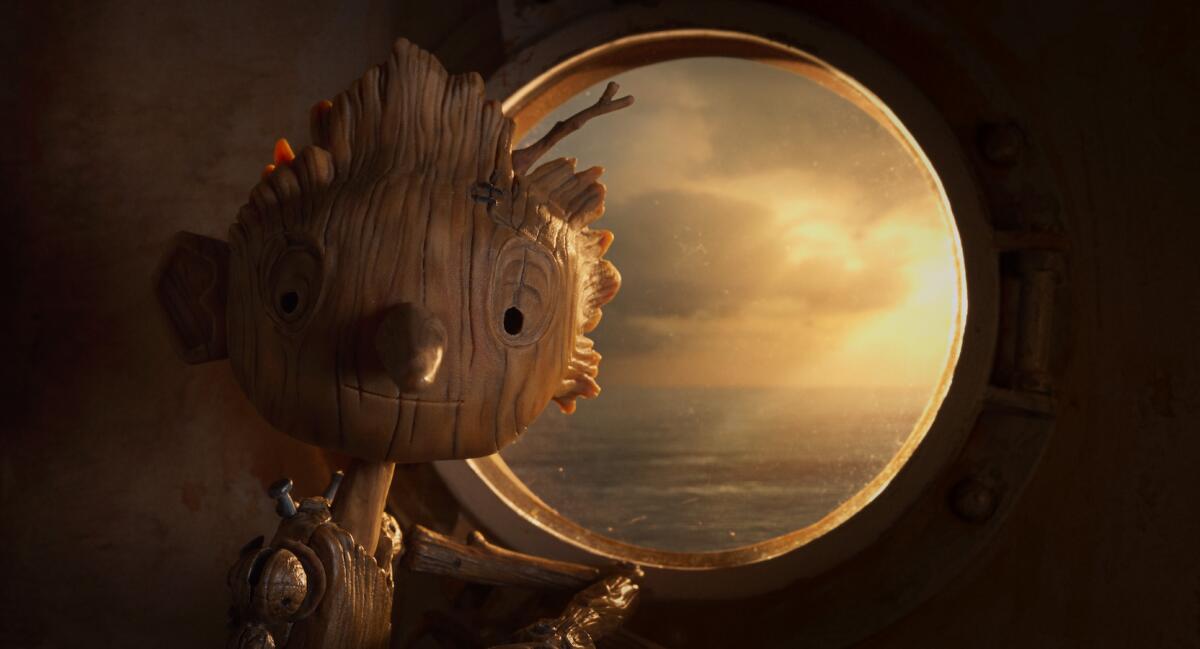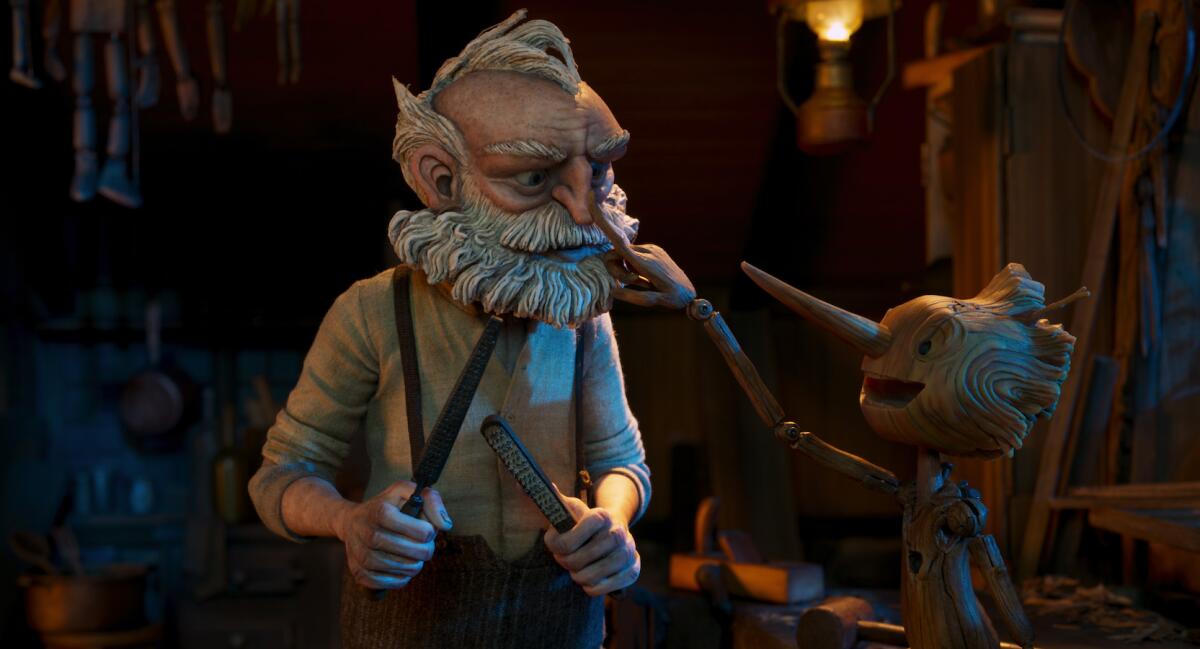‘Guillermo del Toro’s Pinocchio’ entertains and disarms

- Share via
Every “Pinocchio” is some wonder-struck filmmaker’s hope that their carved, sculpted and painted version of Italian author Carlo Collodi’s 140-year-old story about a manufactured boy will be accepted as a real movie someday. (Roberto Benigni and Disney have each tried twice.) Are we surprised, then, that Oscar winner Guillermo del Toro — the closest thing genre cinema has to a Geppetto considering the painstaking care of his imagined worlds — had his own in the works for more than a decade?
And is it any wonder that the choice of stop-motion for “Guillermo del Toro’s Pinocchio” is just the modeling magic this tale needs to feel new-old again? Combining a darker tone closer to Collodi’s spirit with a commedia dell’arte sensibility regarding familiar elements and bizarre tangents, Del Toro, his co-screenwriter Patrick McHale and co-director Mark Gustafson — a stop-motion veteran getting his first feature credit — have made more of a Frankenstein-ed fairy tale than some irreverent answer to the Mouse House’s 1940 hand-drawn classic. That’s a good thing. Sometimes an odd, awkward thing, and at times a naggingly modern thing, but mostly a good thing.
For your safety
The Times is committed to reviewing theatrical film releases during the COVID-19 pandemic. Because moviegoing carries risks during this time, we remind readers to follow health and safety guidelines as outlined by the CDC and local health officials.
It’s clever, for instance, to tweak Collodi’s fixation on discipline over disobedience by simply setting “Pinocchio” during fascist Italy during World War II, when the populace were puppets. But before it gets into “Hunger Games”-meets-“Pan’s Labyrinth” territory in the second half, war is what drops a stray bomb on the mountain village where Geppetto lives, killing his adored son Carlo. That’s the background tragedy that spurs the bereft woodcarver — voiced with crusty finesse by David Bradley — to one night drunkenly build a spindly boy out of pine.
Our six-legged gentleman narrator is Sebastian J. Cricket (Ewan McGregor), here a pompous raconteur frequently subjected to splat gags but still positioned as a commenting conscience. The deep-blue apparition awarding life to Pinocchio (a spirited Gregory Mann) is a kindly but eerie-looking wood sprite (Tilda Swinton), who we later learn has an Underworld sister (also Swinton) named Death. This is Del Toro, remember, so a twig nose growing into a leafy branch isn’t the only consequence for misbehavior, and it goes without saying that the filmmaker’s handling of mortality in his “Pinocchio” is, pardon the pun, unvarnished. I wooden lie to you. (OK I’ll stop.)
Sweet and defiant, Pinocchio has a generous, inquiring soul but succumbs to the corrupting pull of carnival boss Count Volpe (a lushly louche-voiced Christoph Waltz) and his hench-monkey Spazzatura (the noise stylings of Cate Blanchett). But he must also deal with the oppressive eye of a severe Catholic priest (Burn Gorman) in cahoots with a Fascist official (Del Toro fave Ron Perlman), whose son Candlewick (Finn Wolfhard) is jealous of the attention a charmed puppet boy is getting.

Building a lost-art atmosphere of Old World detail in which canonical whimsy can still be mined for critiques about religion and politics, and be resonant about “imperfect fathers and imperfect sons,” as Sebastian tells us, is where this “Pinocchio” works best. When it plays like a hobbyist’s hidden art project come to peculiar life, it entertains and disarms.
Where it stumbles is when it goes neo-frantic kiddie movie — namely the second half’s kid soldiers, Mussolini cameo (an almost Warner Bros. cartoon touch) and monstrous dogfish. The choppy editing of the relentless peril resembles something computer-generated and scaled to pummel, rather than patiently solicitous of a rarely used animation form’s quirky intimacies. It also drives a few of the vocal performances toward shoutiness, while the delicate weirdness of Del Toro’s existentially minded travelogue between worlds loses some of its emotional potency. The songs, though, by composer Alexandre Desplat and often sporting Del Toro’s own lyrics, benefit from being interludes of feeling instead of big showy numbers, particularly the nicely turned “Ciao Papa.”
But it’s all plenty inventive and heart-conscious, grim without being punishing and, in its openness about impermanence and humility, could spark some significant parent-child exchanges about love, flaws and the necessity of meaningful time together. Which makes a bracingly big-picture, big-themed “Pinocchio” like Del Toro’s a worthy movie candidate for a close-knit family’s catalog of shared experiences.
'Guillermo del Toro’s Pinocchio'
Rated: PG, for dark thematic material, violence, peril, some rude humor and brief smoking
Running time: 1 hour, 57 minutes
Playing: Starts Nov. 9, Laemmle Royal, West Los Angeles; Nov. 11, Bay Theatre, Pacific Palisades; Los Feliz 3; available Dec. 9 on Netflix
More to Read
Only good movies
Get the Indie Focus newsletter, Mark Olsen's weekly guide to the world of cinema.
You may occasionally receive promotional content from the Los Angeles Times.







